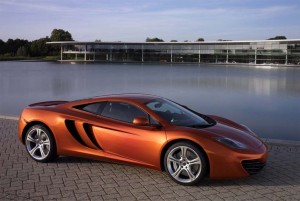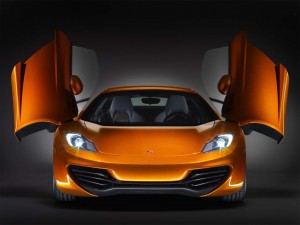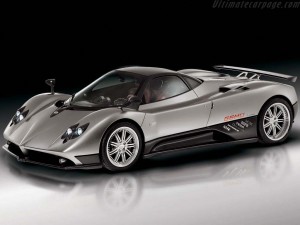
A Formula One car in virtually everything but design, claims McLaren about the new MP4-12C, which will reach production early in 2011.
Best known for its Formula One race cars, the British maker McLaren aims to take on long-time rivals like Ferrari and Porsche, but this time on the street with the track-tuned MP4-12C sports car, which will start at nearly $200,000.
McLaren, which recently was embroiled in scandal on the F1 circuit, is entering the luxury car market at a challenging moment, analysts caution, noting that the ongoing global recession has triggered an auto sales slump that has been particularly hard on the luxury segment. But Ron Dennis, the Chairman of McLaren Automotive, insists it’s a perfect time to launch the MP4-12C.
“Following any recession, there’s a resurgence,” Dennis stressed, during a news conference announcing the new venture, and, “We intend to catch that wave.”
The 12C will borrow heavily from McLaren’s F1 technology. Both Jensen Button, previously an F1 world champion, and McLaren teammate Lewis Hamilton have been test-driving the new sports car for the British maker.
Among the key features are a one-piece carbon fiber chassis, with a design McLaren claims to be a first for a road car, in a Mono Cell. Also known as a “tub” structure, it helps reduce weight while adding significant protection in the event of a high-speed crash. Body panels are a mix of lightweight aluminum and SMC, or sheet molding compound, which McLaren claims to be 11% lighter than used in other production cars. The emphasis on weight savings – critical to performance – led McLaren to even go with a lithium ion battery that’s 22 pounds lighter than a conventional lead-acid battery.
The overall dry weight of the MP4-12C is expected to come in at 2860 pounds, when production launches, next year.

Power for the McLaren MP4-12C will come from a rear-mounted, twin-turbocharged 3.8-liter V8 making 592 horsepower.
But the heart of the new 2-seater will be a rear-mounted, twin-turbocharged 3.8-liter V8 making 592 horsepower. That will be enough to propel it from 0 to 125 mph in less than 10 seconds, and to a top speed of 200 mph. But McLaren officials emphasized that the performance of the engine will be matched by the track-derived brakes, which will be able to bring the car to a dead stop from 60 mph in under three seconds – or less than seven car lengths. From 125 mph to 0 will take less than 5 seconds.
Other key features include McLaren’s Proactive Chassis Control, an electronic system that the maker claims eliminates the need for a conventional, mechanical roll bar. PCC uses a hydraulic system to distribute damper control forces to the appropriate wheel and axle. Meanwhile, an Airbrake system increases downforce, moving it rearward during aggressive braking maneuvers.
The goal, according to Neil Patterson, the project’s chief engineer, is to deliver “accessible performance, no matter what the driver’s ability.”
Sales of the MP4-12C will begin in spring 2011 in 19 countries around the world, with a starting price tag of $191,127, based on the current dollar-pound exchange rate. That’s actually a fair bit less than the Ferrari 458 Italia, at about a third more. The new Mercedes-Benz SLS AMG is targeted as another key competitor, and costs about 20% more than what McLaren expects to command as a starting price on the 12C.
McLaren Chairman Dennis said the company expects to sell 1,000 copies of the MP4-12C during its first year on the market, with 40% earmarked for the U.S., traditionally the world’s largest market for high-performance sports cars.
Long-term, McLaren’s ambitious plan is to roll out variants and new models annually, with a production target of around 4,000 annually, by mid-decade. That number would approach Ferrari volumes, though McLaren Managing Director Antony Sheriff stressed that, “we have no desire at all to be the biggest sports car manufacturer.”
The MP4-12C will be hand-built at a new production facility at McLaren’s headquarters, in Woking, and will eventually create 300 direct jobs, and significantly more at the maker’s suppliers. The $60 million facility might be seen as a major risk for the company, but Dennis stressed that the “frightening statistics” show that it’s even riskier to stay focused solely on Formula One. Since 1966, he pointed, he noted, 101 F1 teams have gone out of business, so to not prepare another line of revenue, “is almost going to surely lead to extinction.”
But it’s actually not the first time McLaren has tried to expand beyond the track. In the mid-1990s, it produced 107 cars that were dubbed, appropriately enough, the F1. The jet-like sports car featured an unusual 3-seat interior layout, with the driver sitting dead center and passengers seated slightly to the rear on either side.
More recently, the Formula One marque helped develop the $400,000 Mercedes-McLaren SLR, a two-seat supercar, with its former F1 race team partner. Production of the SLR recently wrapped up, with Mercedes shifting to the gull-winged SLR, which was developed in-house.



McLaren technology had nothing to do with propelling Jenson Button to a world championship. He won the drivers’ crown in a Brawn GP, a Honda F1-designed chassis powered by a Mercedes (Ilmor) engine.
“Among the key features are a one-piece carbon fiber chassis, a first for a road car…”
Don’t the Ferrari F50 and Ferrari Enzo, both road cars, have carbon fibre tubs as well?
Production on the F50 had started in 1995 and on the Enzo in 2003.